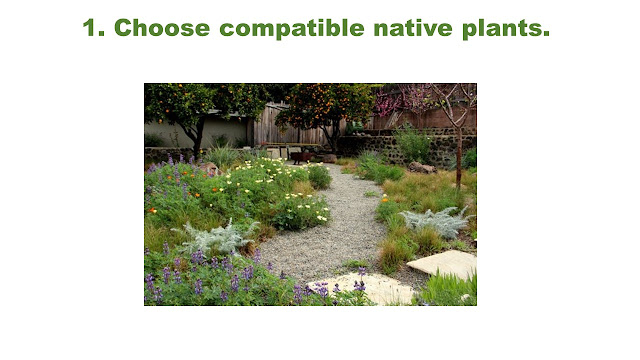Designing a Landscaped Garden
👉 Pinterest
👉 Facebook
You may be thinking about replacing your lawn with something more sustainable. You may have a shady spot where nothing grows. Or you might hope to create more habitat for wildlife like birds and butterflies. A natural garden or landscape is an increasingly popular solution to all these situations, but you may worry that it will be too weedy or messy. Here are five design tips to help you create a space that appeals to both humans and wildlife.
1. Choose compatible native plants.
You've probably heard the saying "right plant, right place," and never has this been truer than in landscape garden design. What this saying means is that if a plant grows in dry clay in full sun in the wild, you should put it in your landscape. Sometimes we force plants into conditions they don't like because the plant is beautiful, but it goes against nature's design. With a little research, you can find all kinds of cool native plants that you didn't know would do well in your site.
Also, if you have a small front yard or garden bed, it's wise to choose species that behave in clumps. This means they won't self-seed or aggressively put out runners. In addition to creating a maintenance headache, unruly plants in too small a space can look really weedy.
2. Repetition is your friend.
Our eyes are evolved to look for patterns in nature to make sense of apparent chaos. In fact, our eyes move in the pattern of fractal geometry (which defines how plants and animals grow, and helps us map beaches and forests). Try it by walking through a meadow. You'll soon notice how you see repeated flowers in space. To get a natural look in your landscape, group 3-5 plants of each type and then repeat it 3, 5 or 7 times. Repetition helps our eyes "read" the terrain and see the scope.
In a natural meadow or woodland, you will also notice how plants grow one on top of the other, close together and in layers. So plant everything 12 inches apart to cover the open ground. This will help shade out weeds and create habitat for birds, frogs and other wildlife.
3. Don't overdo the flowers.
No more than three types of flowering perennials should bloom at the same time. Why only three? This helps not to overwhelm the space with color. But isn't that what we love - tons of flowers and color? Yes, except that too much looks messy and disorganized.
Don't worry, you'll still get plenty of blooms throughout the growing season with this rule of three. At the same time, you will meet traditional garden design and aesthetic expectations in the middle, if the neighbors want to encourage you to follow the forest path (or at least appreciate its beauty). You can always add more later as you gain experience and our wilderness areas gain more recognition.
4. Keep things brief.
This strategy works for basement beds and entire front yards. Generally, choosing species that are less than 2-3 feet tall will provide continuity to the space and help you see over, into, and through the landscape. If you look at it like this, it's comforting; After all, we evolved in grasslands to see distance for predators, where anything that obstructs vision can cause confusion. The same principle applies to busy street corners, where cars need to watch for oncoming traffic and children on bikes. Keep it low and go with the flow.
5. Plant for flowering succession, fall color, winter seed heads.
This last design strategy almost takes care of itself, because plants do: they change leaf color in the fall (even herbaceous perennials), and many have attractive seed heads and umbels in winter. If you have 15-20 species in your landscape, you will naturally have a flowering sequence.
However, the hardest part of the year is between the shoulder seasons – late spring to early summer and late summer to early fall. So focus on the categories that suit your site and these times even if it's just one or two. Winter means Don't forget that it's a season full of design possibilities, and brown has many rich hues.
A landscape garden may be born from wild roots but it is still a garden that requires planning and thought. All the creatures that come through space, humans and birds and spiders and bees, are beautiful, without losing the energy or vibration that supports the environment.






Comments
Post a Comment